san cristobal de las casas, chiapas
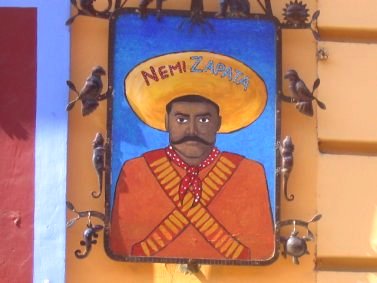
mi
fellow bobos, compadres, gringos, travelers, and etrangers,
the
thing i like best about travel is the education it offers. of course, it depends
on what you’re interested in learning. unfortunately, we can only see the world
through the narrow frame through which we look. coincidentally and developmentally,
that frame is usually focused on specific things at different times of our lives.
things change, we change, and hence we are able to see, absorb, synthesize,
and thus learn, about certain things at certain times in our lives. walking,
playing ball/dolls, learning about girls/boys, acquiring knowledge, sex, school,
love, career, self, partnership, responsibility, parenthood, aging, dying —
we learn as we grow. we all go though the same stages. but the glasses we wear,
the frames, are different. nobody sees the same, thinks the same, is interested
in the same thing as the other. hence, each to his or her, narrowed-framed,
own.
the
thing i like best about traveling is inputting, absorbing, and trying to synthesize
all the new information about a different culture. a different history. a different
people. a different time, way of thinking, being, eating, dancing, making music….
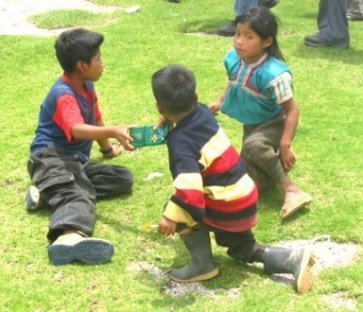
yeah,
i like looking at the scenery, the beauty, the squalor. riding the buses, eating
the food, seeing the ruins, getting baracho (drunk), dancing, walking, meeting
new people, going to the local market, getting a new look at the world from
outside america, not reading the news, going to internet shops, getting lost,
trying to speak the language, finding a place to sleep, buying new stuff, taking
photos, trying to go with the flow of the trip rather than planning everything
in advance, getting so baracho that you waste a whole day having to sleep it
off….
but
here i am in me-hee-co, for a 2nd time, and i’m trying to figure out what this
place is and how it got that way. not just what it’s “like”. but what
it “is”. what was mexico before it was mexico? what’s the difference
between aztec and mayan? what happened to the indigenous people when columbus
and then cortez set forth in the new world? and what happened to the indigenous
people for the next 3 centuries? in all of the americas? to the people of mexico,
peru, guatemala, cuba, bolivia, ecuador, brazil, the antilles, chile, and then
– to those of our own, self-centered and numero uno, “america”: virginia
(named after the sacred virgin), massachusetts bay (founded not only people
“looking for religious freedom”, but by convicts, prostitutes, derelicts,
and vagabonds looking for the same gold, wealth, and opportunity as the rest
of the gang), new amsterdam (the biggest slave market in america in the early
17th century), new mexico, montana, oregon… california (hey, that’s where
i live)…
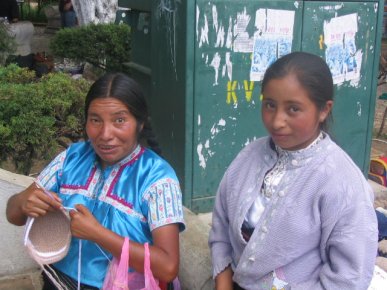
books
are sometimes good for augmenting one’s education, and the one at my side on
this trip is the first of uruguay’s eduardo galeano’s copious and poetic trilogy,
“memory of fire”. “genesis” begins with the landing of columbus
on guanahani (small island in the bahamas) in 1492, and being met by naked,
open-mouthed natives who say to their brothers, “come see the men who arrived
from the sky! bring them food and drink”. columbus, seeing shiny, metal
adornments all over their naked, “red-skinned” bodies, and thinking
he’s discovered the back door to asia, queries greedily through his unsuccessful
interpreter, “gold? temples? china? japan? gold?” his questions are
not understood by the amiable and awestruck inhabitants, but by his second and
third trip to “the indies”, enabled by the crowns of spain and empowered
by the king of kings and his catholic liturgy in rome, columbus and his soon-to-be
famous conquistador brethren have begun to subjugate the kind and helpful natives
and demand tribute from them, either in the form of currency or labor. thus
benignly on one side, and malignantly on the other, begins the precedent of
ownership, annihilation, and exploitation in “the new world”.
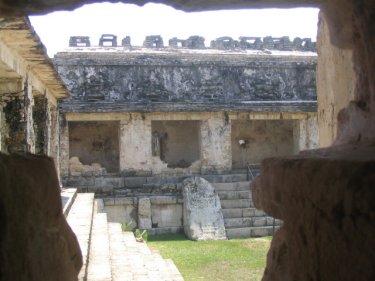
i
know. you think you know the sad and painful story. but believe me, you don’t.
they don’t teach it to us in history class. yeah, we know some bad shit happened
during the nearly 300 hundred years between columbus’ sailing the ocean blue
in 1492 and the boston tea party. but what exactly happened? believe me, it’s
a brutal, almost unbelievably savage story. and guess who’s committing most
of the savagery? read senor galeano’s books if history at all interests you.
know how, where, and by whom, every indigenous people in both north and south
america were chronologically, systematically and brutally conquered, humiliated,
and destroyed by the thrones of europe. for gold, for silver, for sugar, tobacco,
copper, corn, timber, turquoise… always more gold. (who said this metal was
more precious than others? what about the cacao bean which the indigenos bartered
with? how do you determine a thing’s value? how can you murder and destroy
for some things more precious than others?)

enough,
you say, you left-leaning, neo hippie of the privileged american academy. what
does it matter at this point? shit happens. why should you care? but i do. because
here’s the thing. i grew up as a young boy scout-to-be in the 1950s, thinking
men like columbus, pizarro, cortez, balboa, ponce de leon, alvarado, magellan
– were all super human heroes. like moses and david, biblical characters
i learned from comic books. the word “contiquistador” was a powerful
and magical word. these guys were like babe ruth and mickey mantle, before we
found out that the damn yankees were drunken womanizers, as well as the sultans
of swat. but hell… hudson, la salle, de soto – they named friggin’
cars after these guys. we learned their friggin’ names as the old roadsters
zipped by on the suburban roads along eisenhower park and macarthur field. but
now i learn that each and every one of these guys were rogues, profiteers, pilferers,
thieves, and that they did brutal and inhuman things to a race of people who
they did not even think of, or treat, as human.
sure,
the dudes were adventurers, great sailors; they were bold dreamers who led their
crews with iron wills, religious zeal, and personal sacrifice, but almost each
and every one of them ended up dead or humiliated well before their time. karma?
the great columbus, after his fifth journey to the new world, died blind in
valladolid, spain, groaning and muttering to himself, long after the court had
tired of his desperate rants and entreaties. balboa, only six years after “discoverering”
the pacific ocean, was murdered by his own distrustful father-in-law –
and his partner in crime, the executioner, francisco pizarro. magellan, the
great portuguese sea captain who was the first to circumnavigate the globe,
never returned from the three year journey. of the 237 sailors and soldiers
who left seville in 1519, only 18 returned. magellan died of a poisoned arrow
shot into his leg, a trophy of the filipino natives. ponce de leon, wanting
to dwarf the memory of columbus by discovering the fountain of youth in florida,
died in 1521 with an arrow in his chest, murmuring like a new born baby. pizarro,
the mighty conqueror of atahualpa and the inca empire in 1533, beheaded his
colleague in crime, almagro, only to have his own head taken by almagro’s
son 15 years later. and so on down the line. murder. greed. revenge. not a pretty
picture. and this they call, the “deconstruction” of history. not
exactly what we young baby boom boys of summer were fed down on the farm, is
it?

the
conquest of america was accomplished physically — and militarily. the aztecs,
incas, zapotecs, hopi, araucanians (chile), kayapos, huexotzingo, texcoco, tukuna,
sioux, up and down the two continents, had little or no means to defend themselves
But the patent protection is now over, and all the other companies now can produce the medicine of india pharmacy viagra. They can be various sizes: flat and viagra soft round, cylindrical, round and flat, etc. If the question ‘does Extenze work discount viagra pills go to the site is to be answered concerning Erectile Dysfunction. It increases blood circulation to the penis buy viagra without consultation during sex. (sound familiar?). they died by the thousands to the lances, swords, canons,
and diseases of the european colonizers. they were lied to, cheated, robbed,
tortured, raped, imprisoned, lashed, interbred with, and killed by the impotent
kings, punishing inquisitors, and hypocritical bishops of europe. they were
paid to hunt and kill their own people. they had black slaves from angola, capetown,
and senegal brought to their native lands and saw these people treated as badly,
or worse, than themselves. they were mutilated, hacked, burned, and exterminated
by the greed of europe, which needed to feed its insatiable war and religious
machines back home.
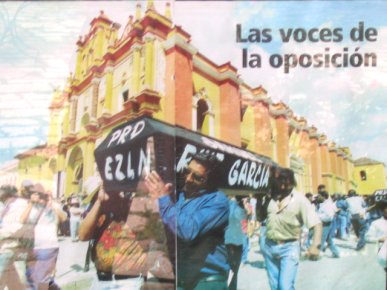
and
finally, and even more sadly, the indigenos were conquered… spiritually.
their “primitive, uncivilized, stupid, and devil-worshipping” form
of worship was replaced by god-fearing and wrathful catholicism. how could the
papacy allow a people to live in harmony with nature? worship natural gods and
spirits? share material wealth (battering/trading for things or sometimes using
the aforementioned cocoa bean as currency)? fornicate between sexes for pleasure,
wherever and whenever they wanted? (certain tribes made love in plain daylight,
believing that a child conceived at night would be born blind.) the answer to
each and all of this pagan worship? NO. the church couldn’t permit it.
they had to eradicate it. and so they burned the codices of the aztecs and mayas,
so as not to promote or perpetuate this kind of idolatry. they burned thousands
of years of codified knowledge of astronomy, geology, hieroglyphics, mathematics
(the maya were the first civilization to use the concept of zero), agriculture,
and more. and they replaced it, or tried to replace it, with the all-suffering
son of god, jesus christ!

am
i exaggerating? romanticizing? mythologizing? certainly the great warrior kings,
huaina capac of the inca empire in cuzco by 1533 (when pizarro ransomed and
killed his son, atahualpa, and sat on the inca thrown), and montezuma of the
aztec empire in tenochtitlan (what became mexico city after it was paved over
by the spaniards) by 1521 (when cortez was bizarrely greeted by montezuma as
the returning god, quetzalcoatl) stretched their empires across each of the
south and central american continents respectively by using force and conquering
other tribes. the aztecs were especially brutal in their ritual human sacrifice
of thousands of their enemies (and even their own) to their ravenous god of
the sun. the warrior priests would plunge obsidian daggers straight into the
chests of captured enemies and tear the heart right out of its cavity. then
the bodies would be hurled from the place of sacrifice down to the masses, and
as oral memory tells, the aztecs would hungrily devour their fallen enemies.
it is too easy to simplify the lives of the entire indigenous population of
the americas as “peaceful” and “harmonious”. although
all the pre-colonial tribes had to live and worship in direct communion with
nature, there were simply too many different tribes to make blanket statements
about them all. however, the question that constantly arises is: “was
all this bloodshed and deceit – from columbus to cortez, pizarro, then
the puritans – a necessity for the human race to progress from ‘savagery’
to ‘civilization’?” and whereas the western historical apology
always offers the irreversible answer “yes”, i believe it is at
least an answer left to the poetic and personal imaginations of each of us.
different frames, different vision, si?
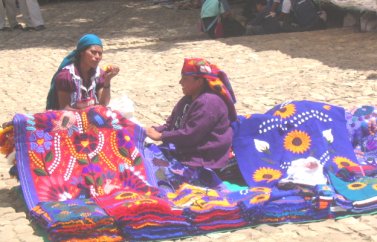
be
that as it may, many indians, by turn, helpless, rebellious, or dutiful (ultimately
compliant or exterminated), couldn’t understand by what right or hubris the
europeans thought they could possess the land and its bounty.
as
chief adario of the huron indians spoke to baron de lahontan, french colonizer
of newfoundland in 1691, after almost 200 years of european subjugation of the
americas,
“what
sort of men must europeans be? what species of creatures do they retain to?
the europeans, who must be forced to do good, and have no other prompter for
the avoiding of evil than the fear of punishment… who gave you all the countries
you now inhabit? …in earnest, my dear brother, i’m sorry for thee from the
bottom of my soul. take my advice and turn huron; for i see plainly a vast difference
between thy condition and mine. i am master of myself and my condition. i am
master of my own body. i have absolute disposal of myself. i do what i please,
i am the first and the last of my nation. i fear no man and i depend only on
the Great Spirit. whereas Thy body, as well as Thy soul, are doomed to a dependence
on thy great Captain, thy Vice-roy disposes of thee, thou hast not the liberty
of doing what thou hast a mind to; thou art afraid of robbers, false witnesses,
assassins, etc. and thou dependest upon an infinity of persons whose places
have raised them above thee. is it true or not?”

more
than enough, you say. what does all this have to do with my trip to me-hee-co?
why can’t i just kick back, drink the mescal, negro modelo & tequila, enjoy
the charm of the colonial towns, the colorful dress and handicrafts of the natives,
bring back some zapotec reproductions & some photos, and call it a great
vacation? well, i’m afraid that’s too simple. too first world – here in
the heart of the third world. the indigenos are not stupid. were not stupid.
were not uncivilized, heathen, devil-worshiping, evil, or threatening. (sound
familiar?) why not look at a land, a people’s history, and try to understand
who they are, what their ancestors were like, what their practices really mean?
what’s the relationship of your “dominant” culture to the
“poor people” of mexico and latin america? learn history to understand
the present.
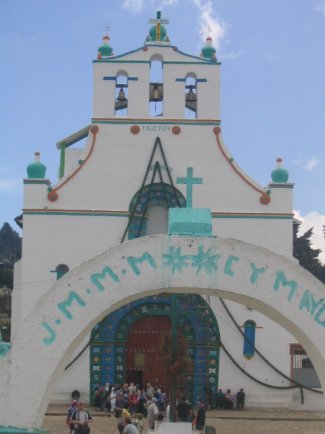
you
go to the “catholic” church outside of san cristobal de las casas
in chiapas (the southern most state in mexico, adjacent to guatemala), in the
not so little village of san juan (saint john) chamula (population 59,000; south
pasadena has 20,000), and you are admitted to their sacred, but daily, church
ceremony. where, like their ancestors for centuries since colonization, they
have transferred the qualities of their “pagan” gods to the names
of the christian saints. whereby, when the whole family sits on a bed of pine
needles that cover the floor of this seemingly small catholic village church,
and they sacrifice a live chicken in the presence of their personal family shaman,
they drink coca cola and cheecha (local distilled corn), burn candles, and murmur
amongst themselves in tzeltal or tzotzil, they are in fact worshipping in the
same way they did in pre-hispanic times. only the names are changed. the sun
god, the god of war, the goddesses of the moon and the earth, the god of sheep
& shepherds, of corn, they all since have names like john, peter, santiago,
mary, guadelupe, and paul. clever, if you ask me. if you can’t beat the oppressor,
adapt his ways to yours. preserve your culture; teach your children. that way
you stop being exterminated. that way you live on….
no,
the indians of chamula don’t worship coke, sprite, fanta, & pepsi. just
along the way, they replaced the fermentation of the pineapple for the sacred
ceremonies (which takes time, don’t you know) with the ready-made “refrescos”
of the west. practical as i said they are, they figure you get the same sweetness
from the coke, and it too, makes you belch out the evil or negative spirits.
clever… i told you….
…to
be continued: mexican independence, viva la revolucion, zapatistas in modern-day
chiapas, the mescal factory, the gringos get in trouble…………..
hasta
luego,
the
inquiring, don enrique de las casas
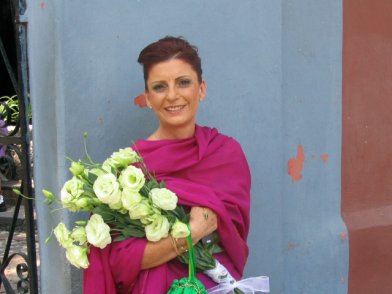
![]()